Costus speciosus (Crepe Ginger) Uses, Research, Remedies, Side Effects
Kebuka- Costus speciosus is a plant mentioned in Ayurveda for the treatment of cough, asthma, dysmenorrhea, skin disease and intestinal worms.
Latin name- Costus speciosus (Koeing Sm.), Cheilocostus speciosus
Family- Zingiberaceae (Ardraka kula)
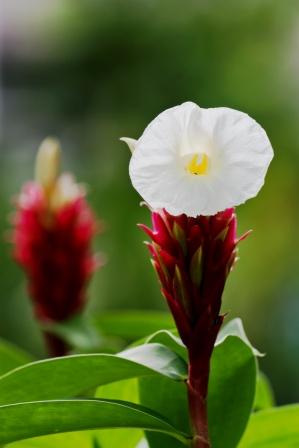
Table of Contents
Vernacular names
Names in different languages:
Hindi name- Kembu, Peyun
English name- Cane reed, Wild ginger, crepe ginger
Kannada name- Chengaluva
Tamil name- Ven kottam, Vasabu
Telugu name- Kevu Kanda
Sanskrit Synonyms
Kevuka, Kembukam
Supatra – It has beautiful leaves
Svalpavitapa – Plant is not becoming so tall
Kushta – Kebuka is used in place of kushta in some areas
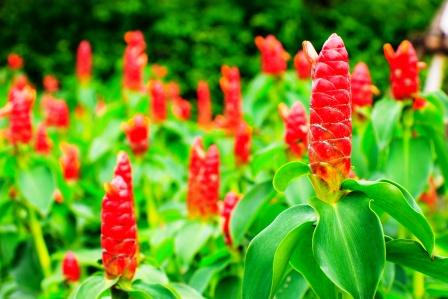
Morphology
Morphology of Costus speciosus:
Kembuka is a small plant growing to a height of 1- 3 m, resembling a ginger plant. The leaves are 6-12 inches long, slightly oval and 3-4 inches wide. The flowers are found in clusters, white in color with a reddish end and 2-4 inches long. They are seen during the rainy season. The rhizomes are slightly slimy, astringent in taste and used like vegetables in some parts of the Indian subcontinent. The plant is seen all over India especially in Assam, Bengal, Goa and parts of Maharashtra.
Properties, part used, dosage
Properties:
Rasa (Taste) – Tikta (Bitter) Kashaya (Astringent)
Guna (Qualities) – Laghu (Light for digestion), Ruksha (Dry in nature)
Vipaka – Katu (Undergoes Pungent taste after digestion)
Veerya (Potency) – Sheeta (Cold)
Karma (Actions) – Kaphpitta shamaka (reduces vitiated kapha and pitta dosha)
Pharmacological action – Anti microbial, Anti fungal, Anti viral, Hypoglycemic, Spasmolytic, Diuretic
Part used- Rhizome
Dosage-
Powder- 3 to 6 g
Juice- 10 to 20 ml
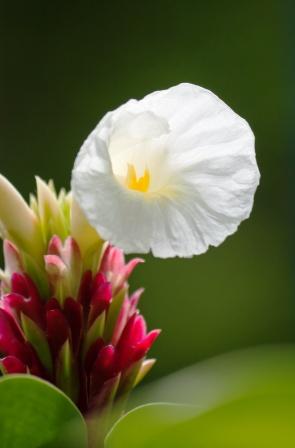
Chemical composition
Chemical composition of Costus speciosus:
The rhizomes contain Costusosides, Saponins- dioscin, gracillin and beta-sitosterol- beta-D-glucoside.
Uses, Sanskrit verse
Uses of Costus speciosus:
- The powder of the rhizome of Kebuka is given in a dose of 3-5 g with honey to treat cough and asthma.
- The powder of the rhizome is given in a dose of 3- 5 g with hot water to treat indigestion and anorexia.
- The fresh juice of the rhizome of Costus speciosus is given to treat difficulty in labor and pain associated during labor.
- The paste of the leaves and rhizome is made into paste and applied locally over the skin affected with discoloration, black spots and itching due to ringworm infection.
- The decoction of the rhizome of Costus speciosus is given in a dose of 20-25 ml in conditions of elephantiasis, fever and intestinal worms.
- The cold infusion of the rhizome of Kebuka acts like blood purifier and hence beneficial in patient suffering from repeated skin diseases.
kebukaM kaTukaM pAke tiktaM grAhi himaM laghu||
dIpanaM pAcanaM hahyaM kaphapittajvarApaham |
kuSTakAsapramehAsranAzanaM vAtalaM kaTu || (bhA.pra)
Uses as per Ayurveda:
Grahi – absorbent, useful in diarrhea, IBS
Deepana – improves digestion strength
Pachana – Digestive, relieves Ama Dosha
Indications
Indicated in –
Jwara – fever of Kapha and Pitta
Kushta – skin diseases
Kasa – cough, cold
Prameha – Urinary tract disorders, diabetes
Asra – blood disorders such as abscess, skin disorders, bleeding disorders such as menorrhagia, nasal bleeding etc.
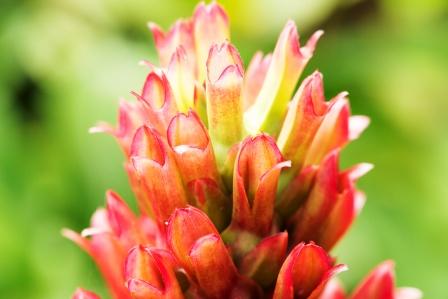
Side effect
No adverse effect is known or reported after the use of Kebuka.
Interaction with medicines, supplements
Can this be used while taking Homeopathic medicine?
Yes. This product does not react with homeopathic medicine.
Can this medicine be continued while taking supplements like multivitamin tablets, Omega 3 fatty acids etc?
Yes. Generally, this product goes well with most dietary supplements. However, if you are taking more than one product per day, please consult your doctor for an opinion.
With western
medicines
Seek your
doctor’s advice if you are taking this product along with other western
(allopathic / modern) medicines. Some Ayurvedic herbs can interact with modern
medicine.
If both Ayurvedic and allopathic medicines are advised together, then it is
best to take Allopathic medicine first, wait for 30 minutes and then take the
Ayurvedic medicine.
Ayurvedic medicines
Ayurvedic medicines containing Kebuka:
Krimighna kashaya: It is a decoction used in the treatment of worm infestation (Helminthiasis) This Kashaya is derived from Krimighna Gana of Charaka.
Asana eladi taila: It is a herbal oil used in the treatment of headache, ear and eye diseases. It is used for external applications only.
Nisoshiradi taila: It is an oil used to treat diabetes carbuncles and abscesses. It helps to heal wounds quickly.
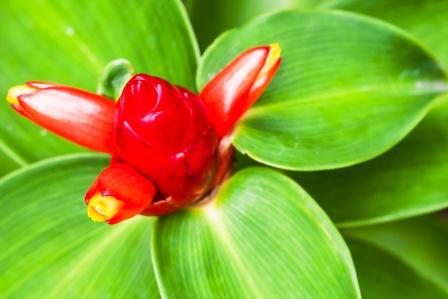
Brihat purnachandra Rasa: It is a medicine in tablet form, used in anti- aging therapy, digestive disorders, cough, cold, asthma, anorexia, abdominal colic pain, low back ache, heartburn, indigestion, gastritis, fistula, jaundice, anemia, urinary tract disorders, gout.
Research
Research articles related to Costus speciosus:
Anti- inflammatory and analgesic effect: In the present study, methanol extracts of Costus speciosus Koen. aerial parts were assessed for antiinflammatory, analgesic and antipyretic activities in experimental animals. The antiinflammatory activity of methanol extract of Costus speciosus (400 and 800 mg/kg, p.o.) was evaluated using carrageenan-induced paw oedema test. Analgesic effect was evaluated using acetic acid-induced writhing and Eddy’s hot-plate models. The methanol extract of aerial parts of Costus speciosus in a dose of 400 and 800 mg/kg showed significant antiinflammatory activity (19.36 and 40.05% reduction) at 5 h postmedication. In analgesic models extract treated animals at (400 and 800 mg/kg) inhibited writhing’s caused by acetic acid by 14.24 and 31.90%, respectively, and it also increased the latency period at both high and low doses which showed the mean reaction time at 16.60±0.355 s and 14.12±0.355 s, respectively, when compared to control in hot-plate test.
Glycation inhibitory effect: The objectives of this study were to assess the in vitro inhibitory effects of Costus speciosus (COS) leaves on ?-amylase and ?-glucosidase activities, fructosamine formation, protein glycation and glycation-induced protein cross-linking. Methanol extracts of COS leaves demonstrated in vitro inhibitory activities on ?-glucosidase, fructosamine formation, glycation and glycation induced protein cross-linking. These findings provide scientific evidence to support the use of COS leaves for hypoglycemic effects with an added advantage in slowing down protein glycation.
Diuretic action: In Pharmacological screening the effect of aqueous and alcoholic extracts of rhizomes of Costus Speciosus Linn was evaluated in Albino rats of either sex (150-200g) for diuretic activity at a dose of 250mg/kg. b.w. The effect was compared with furosemide (100 mg/kg. b.w.) as a standard drug in diuretic activity. Both extracts significantly increased the urine output as well as urinary electrolyte concentration. Pet. Ether was found to be least potent. Thus from study and literature, It can concluded that Costus speciosus Linn have potent diuretic activity.
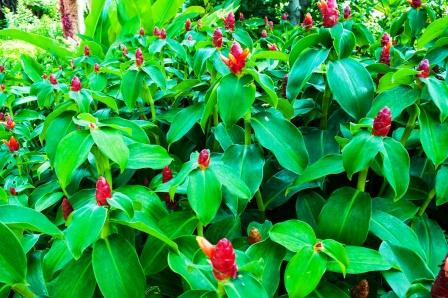
Anti- microbial action: Antimicrobial activities of the essential oil, organic extracts of the dried roots of Costus speciosus were scored on the basis of the change in the general shape of the fungal spores SEM analysis. The results showed that in vitro treatment of fungi by the essential oil led to hyphae disruptions and changes in the fungal spore shapes. The studies on the antimicrobial activity showed high growth inhibition for Microsporum gypseum, M. canis, Candida albicans, Pseudomonas aeruginosa and Staphylococcus aureus when challenged with concentrated oil extract. Methanol and ethanol extracts of the oil exhibited an inhibitory effect on the fungi, yeast and bacteria, while the constituent diosgenin epoxide ingredient in the oil showed higher in vitro growth inhibitory activity than diosgenin against M. gypseum, C. albicans and C. tropicalis.
Classical categorization
Charaka samhita-
Krmighna – group of herbs useful in the treatment of intestinal worm infestation
Tikta skandha – bitter tasting group of herbs
Bhavaprakasha- Haritakyadi varga
Author: Dr.B.K.Prashanth M.D (Ayu), Ph.D
E mail: [email protected]
Click to consult Dr Prashanth BK
Systemic Action (Sthanika Karma)
Digestive System – carminative, digestant, absorbent Anthelmintic. Indicates in indigestion, Malabsorption syndrome, Helminthiasis, etc.
Respiratory system – Indicated in cough and breathing difficulty
Reproductive System – It is a strong uterine stimulant. Can be given in conditions like delayed labor.
Excretory system – Indicated in diabetes
Satmikarana – Indicated in obesity and related conditions
Tapakrama – Indicated in fever
Tvak – Kushtaghna










